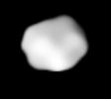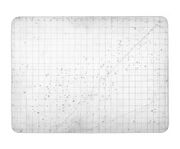Astronomy:51 Nemausa
 | |
| Discovery | |
|---|---|
| Discovered by | J. Laurent |
| Discovery site | Nîmes |
| Discovery date | January 22, 1858 |
| Designations | |
| (51) Nemausa | |
| Pronunciation | /nɛˈmɔːsə/[1] |
| Named after | Nemausus |
| Minor planet category | Main belt |
| Adjectives | Nemausian /nɛˈmɔːsiən/ |
| Orbital characteristics | |
| Epoch December 31, 2006 (JD 2454100.5) | |
| |{{{apsis}}}|helion}} | 2.523 AU (377.381 Gm) |
| |{{{apsis}}}|helion}} | 2.208 AU (330.360 Gm) |
| 2.365 AU (353.871 Gm) | |
| Eccentricity | 0.066 |
| Orbital period | 3.64 a (1328.853 d) |
| Mean anomaly | 316.668° |
| Inclination | 9.972° |
| Longitude of ascending node | 176.168° |
| 2.820° | |
| Physical characteristics | |
| Dimensions | c/a = 0.77±0.04[2] 170×136 km[3] |
| Mean diameter | 150±3 km[2] |
| Mass | (3.9±1.6)×1018 kg[2] (2.48±0.86)×1018 kg[4] |
| Mean density | 2.2±0.9 g/cm3[2] 1.43±0.50 g/cm3[4] |
| Geometric albedo | 0.09 (calculated)[2] 0.093[5] |
| G | |
| Absolute magnitude (H) | 7.35 |
Nemausa (minor planet designation: 51 Nemausa) is a large main-belt asteroid that was discovered on January 22, 1858, by Joseph Jean Pierre Laurent. Laurent made the discovery from the private observatory of Benjamin Valz in Nîmes, France . The house, at 32 rue Nationale in Nîmes, has a plaque commemorating the discovery. With Laurent's permission, Valz named the asteroid after the Celtic god Nemausus, the patron god and namesake of Nîmes during Roman times.[6]
Based upon its spectrum, this is listed as a C-type asteroid in the Tholen classification taxonomy, and as a Cgh by Bus and Binzel (2002). This indicates a composition similar to carbonaceous chondrite meteorites. Absorption features in the spectrum indicate the presence of phyllosilicates.[7] It may have a water content of about 14%.[8]
The first stellar occultation was observed on August 17, 1979, from the Gissar and Alma-Ata observatories produced two chords which were used to estimate a diameter of 150 km for the asteroid.[9] This is close to the present-day estimate of 147.9 km. Since then 51 Nemausa has been observed 20 times[10] in stellar occultation.
Light curve inversion model DAMIT 1065 is a good match to a seven-chord occultation observed on 3 September 2016, from which an equivalent Volume mean diameter of 146.4 km, and an equivalent Surface mean diameter of 150.3 km was obtained.
Lightcurve data suggests that it may have a small moon.[11] Nemausa has been studied by radar.[12]
See also
References
- ↑ John Craig (1869) The Universal English Dictionary
- ↑ 2.0 2.1 2.2 2.3 2.4 P. Vernazza et al. (2021) VLT/SPHERE imaging survey of the largest main-belt asteroids: Final results and synthesis. Astronomy & Astrophysics 54, A56
- ↑ "Diameters". Astronomical Applications Department of the U.S. Naval Observatory. http://aa.usno.navy.mil/AsAtest/SecG/Diameters.txt.
- ↑ 4.0 4.1 Carry, B. (December 2012), "Density of asteroids", Planetary and Space Science 73: pp. 98–118, doi:10.1016/j.pss.2012.03.009, Bibcode: 2012P&SS...73...98C. See Table 1.
- ↑ Asteroid Data Sets
- ↑ Schmadel, Lutz D. (2003). Dictionary of Minor Planet Names. Springer Science & Business Media. p. 20. ISBN 978-3-540-00238-3. https://books.google.com/books?id=KWrB1jPCa8AC&pg=PA20.
- ↑ Reynolds, C. M. et al. (March 2009), "Compositional Study of 51 Nemausa: A Possible Carbonaceous Chondrite-like Asteroid", 40th Lunar and Planetary Science Conference, (Lunar and Planetary Science XL), held March 23–27, 2009 in The Woodlands, Texas 73, Bibcode: 2009LPI....40.1285R.
- ↑ A. S. Rivkin (2002). "CALCULATED WATER CONCENTRATIONS ON C CLASS ASTEROIDS" (PDF). Lunar and Planetary Institute. http://www.lpi.usra.edu/meetings/lpsc2002/pdf/1414.pdf.
- ↑
- ↑ "Asteroid Data Sets". https://sbn.psi.edu/pds/resource/occ.html.
- ↑ Other reports of asteroid/TNO companions
- ↑ "Radar-Detected Asteroids and Comets". NASA/JPL Asteroid Radar Research. http://echo.jpl.nasa.gov/asteroids/.
External links
- 51 Nemausa at AstDyS-2, Asteroids—Dynamic Site
- 51 Nemausa at the JPL Small-Body Database
 |



